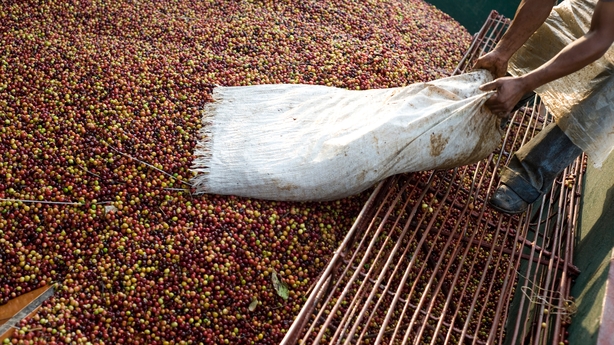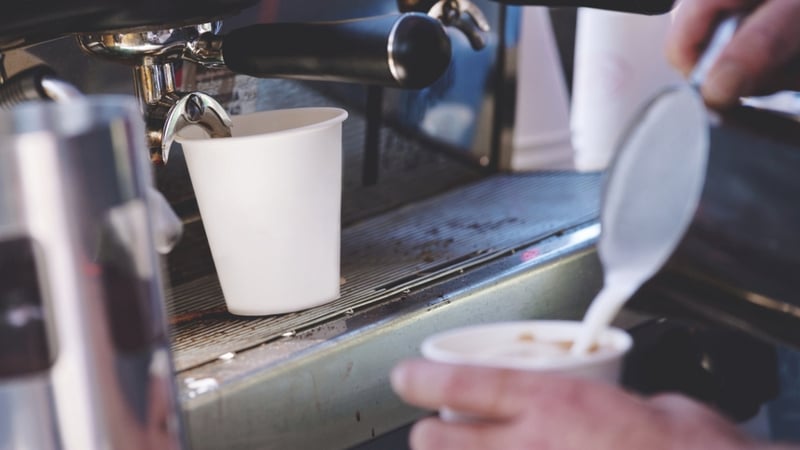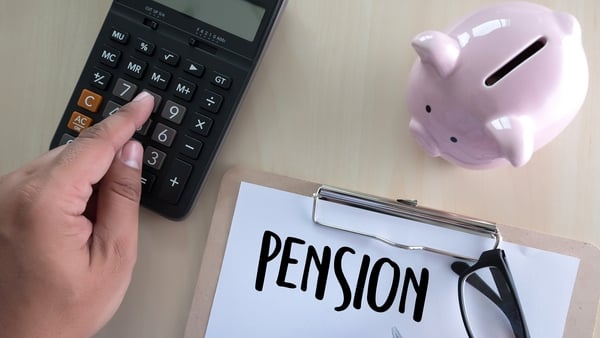The cost of your average shop is going up, with a new estimate from Eurostat suggesting consumer prices rose here by 8.2% in the year to the end of May.
That translates into significantly bigger shopping bills - according to Kantar it means the average household will be paying €330 more each year.
But not all price rises are equal, and a myriad of factors affect different products in different ways.
To help make sense of what’s going on, we’ve taken a closer look at a selection of everyday grocery items.
Each one has seen significant price increases, but each one has a different story to tell as to the reasons why.
In this piece, we’ll look at coffee prices.
What's pushing up coffee costs?
We need your consent to load this rte-player contentWe use rte-player to manage extra content that can set cookies on your device and collect data about your activity. Please review their details and accept them to load the content.Manage Preferences
Adam Maguire talks about the cost of coffee on RTÉ Radio 1's Today with Claire Byrne
Brexit has caused significant disruption to Ireland's supply chain – but it’s not been the only issue. The pandemic is the other big one.
That’s because, in the early stages of the pandemic, all but the most important factories around the world closed their doors and the world’s ports essentially shut down too.
That resulted in massive cargo ships queuing up at ports with nowhere to go – and empty shipping containers building up because there was no way to stock them and put them onto ships.
And it’s not the case that everything starts flowing smoothly again once ports reopen – these backlogs take time to unwind.
The fact that we also had the blockage of the Suez Canal and rolling shut downs in ports in China has just made the situation worse.
So what impact does that have?
Pre-pandemic, the global supply chain meant it was easy, and often cheap, for companies to source goods from the other side of the world.
According to the International Monetary Fund, about 80% of the world’s traded goods are transported by sea. And it ran pretty much like clockwork, too; companies knew they could order goods now and they’d arrive within a predictable number of days.
As a result a lot of businesses operated on what’s called a 'just in time’ model. The idea of this is that they order parts and products as they’re needed, instead of building up a bit stockpile that has to be worked through.
The benefit is that firms don’t tie up lots of cash in goods that just sit there in storage – but the downside is that when there’s a major blockage on the other side of the world – as came with Covid – they don’t have their own stockpile to fall back.
And when the pandemic hit, that led to bidding wars for space on the few containers that were making their way out of ports. The longer the shipping distance was, the more firms were having to pay.
But shipments have also become much slower, and less predictable – because ports seem to be giving priority to premium goods, and those seen to be less valuable end up having to wait longer for space on a ship.
The disruption was such that you also have this strange phenomenon of empty shipping containers piling up in some parts of the world, waiting to be filled, while at the same time you have goods in other parts of the world waiting for a container so they can be put on a ship.
It has even led to some firms paying top dollar to ship empty boxes from one part of the world to another, just to try to get their supply chain back on track.
What has that got to do with coffee?

Obviously there’s no local sourcing possible when it comes to coffee – you have to go to very far away places like Brazil, Vietnam, Colombia or India to get it.
So you’ve no choice but to pay the shipping costs, whatever they are.
And they’ve really ratcheted up since the pandemic.
According to the IMF, there’s been a seven fold increase in the cost of shipping a container across the oceans in the 18 months since March 2020.
But other factors beyond shipping are hitting coffee prices, too.
Higher energy prices mean it costs more to roast beans and transport the finished product to shops, for example.
And the price of coffee itself is going up too.
The US Coffee C Futures is a commodity market that tracks the price of specialty coffee, and it’s used as a benchmark when pricing orders.
It’s up about 50% in the past year – and it’s more than doubled in the past two years – in part because of weather warnings coming out of Brazil that traders had feared would impact the harvest.
And this is hurting the big guys just as much as the smaller players.
Starbucks upped its prices in October, and again in January – and said more hikes are coming – all because supply chain costs, as well as labour costs, were hitting its bottom line.
According to the CSO, coffee prices jumped by almost 3% between March and April – so in just one month – and are about 4% higher in the year, so tracking just above the rise in grocery prices overall.






